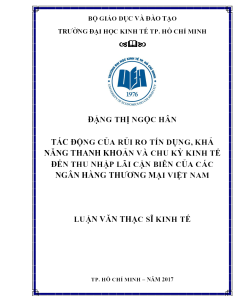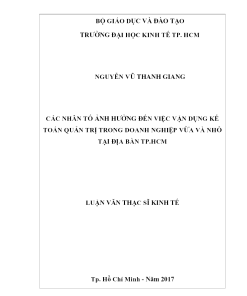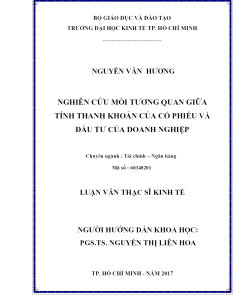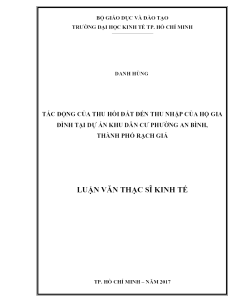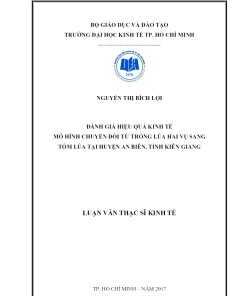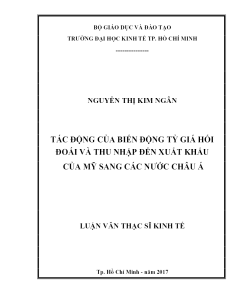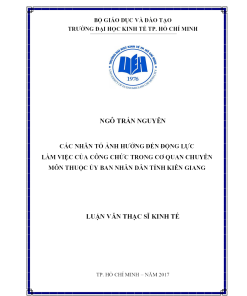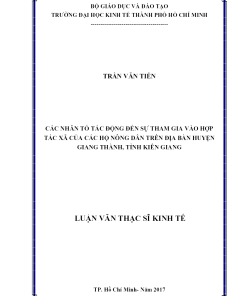Download Master Thesis: Ineffective task allocation of mortgage business service team at bank H (ThS08.103)
From the beginning of 2019, customer centricity and healthiest human system are some of the emerging focus of all levels in the H group and H Vietnam in specific. From 2020, adding two more strategies which are operational efficiency and cost management. To promote such strategies, everyone in bank H has to take actions to review, improve, and simplify processes, procedures, systems, etc.…in order to upgrade customer services and experience, and encourage better work-life balance for the workforces to have the healthier working conditions.
Currently, in Mortgage Business Service (MBS) – a team in the department Cards, Loans, and Mortgage Business Service (CLMBS), the ineffective task allocation is a long-lasting problem that leading to high overtime (OT) and high time-consuming processes. Therefore, this ineffectiveness is a big obstacle for implementing customer centricity, the healthiest human system, operational efficiency, and cost management in the short term and developing team in the long run. The mentioned above finding is located by several qualitative in-depth interviews with VP, manager, and employees of the CLMBS department.
Viết thuê luận văn thạc sĩ bằng tiếng Anh
Combining with analysis from secondary data and related literature, this paper is to step by step diagnose the most concerning symptoms with its consequences, identify the real problems, then explore the potential causes and main causes. Applying theory-informed problem-solving in the organization to study and analyze the current task allocations, the nature of tasks, the competency, and motivation of each employee of MBS, the author aims to support the management of the CLMBS department to understand about the real problem clearly and objectively.
Subsequently, this paper can suggest the CLMBS department the alternative solutions and action plans to generate an effective task allocation to resolve the real causes, symptoms, and negative impacts on the department, team members, and customers. Then, they can evaluate and choose the best and most applicable solutions not only to serve customers in the best way by committing the services, improving processing time but also to equip the team members with methodologies and tools to arrange the workload more scientifically, maximize the capacity and minimize overtime.
ThS08.103_Ineffective task allocation of mortgage business service team at bank H
Ineffective task allocation of Mortgage Business Service team at Bank H 3
INEFFECTIVE TASK ALLOCATION OF MORTGAGE BUSINESS SERVICE TEAM AT BANK H
Executive summary....................................................................................................................... 7
1. Company introduction ............................................................................................................. 8
1.1. Background......................................................................................................................... 8
1.2. Organization Chart ............................................................................................................ 8
1.3. Objective and Scope ......................................................................................................... 10
1.4. Process map of Mortgage Business Service ................................................................... 11
2. Company context .................................................................................................................... 12
2.1. Symptom 1: High overtime in MBS ............................................................................... 12
2.1.1. Definition of overtime and impact of overtime ........................................................... 12
2.1.2. Diagnosis and analysis................................................................................................. 14
2.2. Symptom 2: High time-consuming process in MBS...................................................... 16
2.2.1. Definition of time-consuming process and impact of time-consuming process ......... 16
2.2.2. Diagnosis and analysis................................................................................................. 16
2.3. Symptom 3: High number of document errors in MBS ............................................... 18
2.3.1. Definition of document error and impact .................................................................... 18
2.3.2. Diagnosis and analysis................................................................................................. 19
3. Problem identification ............................................................................................................ 20
3.1. Preliminary cause and effect tree ................................................................................... 20
3.2. Potential problem ............................................................................................................. 23
3.2.1. High job demand and job control in team MBS .......................................................... 24
3.2.2. Ineffective task allocation in team MBS ..................................................................... 26
3.2.3. Low staff capability of team MBS .............................................................................. 29
3.2.4. Poor quality of applications in team MBS................................................................... 30
3.3. Problem Validation .......................................................................................................... 30
3.3.1. Management perspective ............................................................................................. 36
3.3.2. Employees’ perspective............................................................................................... 37
3.4. Real problem..................................................................................................................... 38
4. Cause analysis.......................................................................................................................... 39
4.1. Causes exploration ........................................................................................................... 39
4.1.1. Lack of clear objective for task completion ................................................................ 39
Ineffective task allocation of Mortgage Business Service team at Bank H 4
4.1.2. No base on staff competency, personality, and motivation ......................................... 41
4.1.3. Low flexibility and robustness .................................................................................... 42
4.2. Causes validation.............................................................................................................. 43
5. Alternative solutions ............................................................................................................... 48
5.1. Alternative solution 1: Build Key Performance Indicators (KPIs) of Balanced Scorecard (BSC) by analytical hierarchy process (AHP) and Simple Multi-Attribute Rating Technique (SMART) .................................................................................................. 49
5.1.1. Solution exploration .................................................................................................... 49
5.1.2. Methodology................................................................................................................ 53
5.1.3. Design a KPIs of BSC using AHP and SMART for MBS .......................................... 55
5.1.4. Benefit and cost ........................................................................................................... 58
5.2. Alternative solution 2: Create competency dictionary for team members using
Knowledge, Skill and Attribute (KSA) model ...................................................................... 61
5.2.1. Solution exploration .................................................................................................... 61
5.2.2. Methodology................................................................................................................ 64
5.2.3. Design a competency dictionary for MBS .................................................................. 65
5.2.4. Benefit and cost ........................................................................................................... 69
5.3 Solution justification:........................................................................................................ 71
6. Action plan for implementation............................................................................................. 72
7. Supporting information.......................................................................................................... 73
7.1 Interviewees’ Demographic.............................................................................................. 73
7.2. Interview guides................................................................................................................ 73
References .................................................................................................................................... 80
Appendices................................................................................................................................... 84
Ineffective task allocation of Mortgage Business Service team at Bank H 5
List of abbreviations and definition
RBWM Retail Banking and Wealth Management – a global business serving
Retail customers
OPS Operations – a global function
CLMBS Cards, Loans and Mortgage Business Service – target department
MBS Mortgage Business Service – target team in CLMBS department
SLA Service Letter Agreement – a commitment to complete service within a specific time
SUT Standard Unit time – standard processing time for a specific task
TAT Turnaround Time – actual total time from receiving a request until completion
OT Overtime – working time after agreed time in contract
ID card Identity card – personal information card
QAS Quality at Source – the quality of application provided by Sales
CIC Credit Information Center - government department to provide credit information of customer
HUB H Universal Banking – core banking system
AAPS Application Processing System – core lending system
SFE Staff Front End – core banking system
KPIs Key Person Indicators – is an evaluation criterion that demonstrates how effectively a company/team/person is achieving the objectives
BSC Balance Scorecard
Ineffective task allocation of Mortgage Business Service team at Bank H 6
List of diagrams
Diagram 1: Preliminary cause and effect tree (Source: Consolidated by author) ....................................... 21
Diagram 2: Cause and effect tree (Source: Consolidated by author) .......................................................... 24
Diagram 3: Behavior mechanism................................................................................................................ 31
Diagram 4: Official cause and effect tree (Source: Consolidated by author) ............................................. 38
Diagram 5: Updated official cause and effect tree (Source: Consolidated by author)................................ 39
Diagram 6: Final cause and effect tree (Source: Consolidated by author).................................................. 48
Diagram 7: The Balanced Scorecard Links Performance Measures (Adapted from research)................... 51
List of figures
Figure 1: Organization Chart of Bank H (Sources: Internal data) ................................................................ 9
Figure 2: Organization Chart of CLMBS (Sources: Internal data as at 01Dec2019) ................................. 10
Figure 3: Organization Chart of MBS (Sources: Internal data as at 01Dec2019)....................................... 11
Figure 4: End to end process of home loan (Source: Internal procedure)................................................... 11
Figure 5: The dynamic interactions between the model sectors ................................................................. 13
Figure 6: Total average OT and total volume of CLMBS separated by team from June to November 2014) Figure 7: Percentage of SLA failure in CLMBS separated by team from June to Dec 2019 ..................... 17
Figure 8: Percentage of application with errors in CLMBS separated by team from June to November
2019 (Source: Internal data)........................................................................................................................ 20
Figure 9: Job description of MBS team members (Source: Internal data).................................................. 25
Figure 10: Job requirements of MBS team members (Source: Internal data)............................................. 30
List of tables
Table 1: Total average OT and total volume of MBS from June to November 2019................................. 15
Table 2: Maximum capacity, SLA and actual time of MBS in 2019 (Source: Internal data) ..................... 17
Table 3: Total volume of MBS divided by tasks from June to November 2019 (Source: Internal data) ... 18
Table 4: Average volume of MBS per day divided by tasks from June to November 2019 ..................... 18
Table 5: Constructs of Capacity, Capability, and Performance in Relation to the Role of Contextual
Factors Construct ........................................................................................................................................ 28
Table 6: Average SUT of team in CLMBS separated by teams from June to November 2019 ................ 33
Table 7: Current tasks allocation of MBS separated by person in charge (Source: Internal data) ............. 34
Table 8: Time conflict of tasks MBS separated by person in charge (Source: Internal data)..................... 35
Table 9: Percentage of application with errors: return to sale in MBS from June to Nov 2019 ................ 36
Table 10: Performance objectives of team MBS (Source: Internal data –appendix 8)............................... 45
Table 11: Scale of relative importance (Adapted from research) ............................................................... 53
Table 12: Preference matrix........................................................................................................................ 56
Table 13: Normalized matrix ...................................................................................................................... 57
Table 14: Estimated spending time for solution KPI of BSC (Prepared by author) ................................... 60
Table 15: Example of competency item rating (given by author)............................................................... 68
Table 16:Training proficient ranking (Source: Internal data) ..................................................................... 69
Table 17: Proficient level of using business systems and processes (Source: Internal data) ...................... 69
Table 18:Estimated spending time for competency dictionary (Prepared by author) ................................. 71
Table 19: Action plan for KPIs of BSC and competency dictionary (Prepared by author) ........................ 72
Ineffective task allocation of Mortgage Business Service team at Bank H 7
Executive summary
From the beginning of 2019, customer centricity and healthiest human system are some of the emerging focus of all levels in the H group and H Vietnam in specific. From 2020, adding two more strategies which are operational efficiency and cost management. To promote such strategies, everyone in bank H has to take actions to review, improve, and simplify processes, procedures, systems, etc.…in order to upgrade customer services and experience, and encourage better work- life balance for the workforces to have the healthier working conditions. Currently, in Mortgage Business Service (MBS) – a team in the department Cards, Loans, and Mortgage Business Service (CLMBS), the ineffective task allocation is a long-lasting problem that leading to high overtime (OT) and high time-consuming processes. Therefore, this ineffectiveness is a big obstacle for implementing customer centricity, the healthiest human system, operational efficiency, and cost management in the short term and developing team in the long run.
The mentioned above finding is located by several qualitative in-depth interviews with VP, manager, and employees of the CLMBS department. Combining with analysis from secondary data and related literature, this paper is to step by step diagnose the most concerning symptoms with its consequences, identify the real problems, then explore the potential causes and main
causes.
Applying theory-informed problem-solving in the organization to study and analyze the current task allocations, the nature of tasks, the competency, and motivation of each employee of MBS, the author aims to support the management of the CLMBS department to understand about the real problem clearly and objectively. Subsequently, this paper can suggest the CLMBS department the alternative solutions and action plans to generate an effective task allocation to resolve the real causes, symptoms, and negative impacts on the department, team members, and customers. Then, they can evaluate and choose the best and most applicable solutions not only to serve customers in the best way by committing the services, improving processing time but also to equip the team members with methodologies and tools to arrange the workload more scientifically, maximize the capacity and minimize overtime.
Ineffective task allocation of Mortgage Business Service team at Bank H 8
1. Company introduction
1.1. Background
H Banking group is one of the world’s largest banking and financial services organizations. Group serves more than 40 million customers in 65 countries and territories with 238,000 employees around the world. Exceptional access to high-growth markets and a strong balance sheet are the advantage of the group. Based on that, the group builds the strategy to capitalize on long-term trends affecting the financial services industry. From June 2018, after a long period of transformation, the group is now to refocus on growth to increase customer numbers, take market share, and grow revenue and profits. To do that, the group’s strategies are customers with customer-centricity and people development to fulfill the potential of online University, and care for staff with the Healthiest Human System program, increase the efficiency of operation, and cost management.
H Viet Nam Bank (Bank H) is opened its first office in Saigon (now Ho Chi Minh City) in
1870. In August 1995, Bank H opened a full-service branch in Ho Chi Minh City. Now, Bank H has 14 branches in Ho Chi Minh City, Ha Noi, Da Nang, and Binh Duong and serves both retail and wholesale customers with all available financial services in the market. Adhering with the group, bank H is focusing on customer centricity, healthiest human system, operational efficiency, and cost management to continuously improve and develop the bank. Bank H offers a lot of solutions for wholesale customers for import, export, and guarantees including working capital, growth, payment, investment, and managing risk. In term of retail banking, Bank H have offered several products including Visa and MasterCard credit card, debit card, accounts and deposits and lending products, insurance, and investing. With continuous effort, Bank H has achieved a lot of awards: best foreign bank in Viet Nam from 2006 to 2012, 2014 to 2019 by Finance Asia, a best retail bank in Viet Nam in 2016, 2017, and 2019 as per Banking and Finance Asia…
1.2. Organization Chart
Bank H follows the group structure to divide departments by Global Business and Global Functions. All global business and function units have to report to entity manager in country level and functional manager at regional, and global levels. In this paper, it is mentioned the entity manager reporting line in Viet Nam only. Figure 1 shows the organization chart by businesses and functions.
Ineffective task allocation of Mortgage Business Service team at Bank H 9
Figure 1: Organization Chart of Bank H (Sources: Internal data)
Each department has allocated in job scope to different positions. Below is specification in each department of organization:
Retail Banking and Wealth Management (RBWM): serve retail customers including sale, and service via branches, transaction offices, tele sale, mobile sales, contact centers, marketing, products, underwriting service and collection.
Wholesale Banking (WSB): serve wholesale customers including sale and service. Global Market (GM): perform liability trading transaction.
Global Trade and Receivable Finance (GTRF): provide import and export payment transactions for wholesale customers.
Legal Consulting (LGA): provide legal consultation for all banking activities.
Ineffective task allocation of Mortgage Business Service team at Bank H 10
Regulatory Compliance (RC): provide regulatory compliance consultation for all banking activities, working directly with government.
Corporate Real Estate (CRE): provide real estate management like offices, and securities. Securities Services (SS): provide securities transaction for WSB customers.
Finance Crime Risk (FCR): manage finance crime monitoring including anti money laundering, fraud, anti-bribery and corruption, sanction…
Technology (IT): provide hardware, software, network, and project management. Operations (OPS): delivery operation services for RBWM and WSB related to
documentations, system handling,
RBWM Credit Risk (CR): manage RBWM portfolio and policy.
Communication (COM): manage internal and external communication on behalf of bank. Internal Audit (IA): perform internal audit for the bank.
Corporate Sustainability (CS): perform staff and social activities. Wholesale Risk Management (RM): manage WSB portfolio and policy.
Finance (FCD): perform financial reporting, accounting, planning and tax compliance. Human Resources (HR): perform human resource activities like recruiting, onboarding,
training, staff benefit and advise.
1.3. Objective and Scope
This paper primarily targets CLMBS, which is a department in Operations function, is fully in charge of the operation process for retail banking customers. CLMBS supports RBWM with credit card onboarding, maintenance, payments, card dispute, fraud investigation, settlement, loan
onboarding, documents issuance, loan disbursement, and servicing.
Figure 2: Organization Chart of CLMBS (Sources: Internal data as at 01Dec2019)
After doing research, the scope of this the paper is to focus on MBS team only who takes responsibility for mortgage home loan including capturing, credit and mortgage documents
Ineffective task allocation of Mortgage Business Service team at Bank H 11
issuance post approval, disbursement, and servicing. Figure 3 displays the current structure of team
MBS.
Figure 3: Organization Chart of MBS (Sources: Internal data as at 01Dec2019)
During observation, secondary data analysis, and in-depth interviews, this team shows the most abnormal figures and trends in comparison with other teams in the same department. By making comparisons with peers and standards, some symptoms are happening too seriously that draw the attention of the team head and researcher to find out the problems, causes and solutions to resolve as soon as possible.
1.4. Process map of Mortgage Business Service
Figure 4: End to end process of home loan (Source: Internal procedure)
In end to end process of home loan, MBS is in charge of capturing, document issuance and disbursement. In all processes, staff use some core systems:
GWIS: Core data storage of scanned version of documents including applications, supporting documents including ID, family record book, marriage certificate, land use right….and record all processing steps. Team members get information from GWIS and add remark their actions in every step for storing purpose.
HUB: Core banking system stores all banking information. Team members use HUB to
check, verify and make dump screen of customers’ information to GWIS.
Ineffective task allocation of Mortgage Business Service team at Bank H 12
AAPS: Core lending systems which is linked with HUB. All customer information and lending information is captured to AAPS. Then the loan is approved and disbursed by separate functions in AAPS. After disbursement, the fund is available and can be checked in HUB. At the time, customer can withdraw the fund.
SFE: Staff front end system which is linked to HUB. Team members use SFE to view lending information and book manual loan in case of AAPS cannot be used.
As per figure 4, the application firstly comes from the face to face meeting between RBWM sale and customers to MBS. Sale scans soft copy to MBS by GWIS. MBS staff checks information and captures information to AAPS system and route that form to Underwriting service function to verify and approve a credit limit to customer. After getting final approve which is in AAPS and GWIS, MBS perform step 4 to issue credit and mortgage documents manually. After the documents are registered successfully in local authority, sale instructs customer to fill in some necessary forms and submit to disbursement. Finally, MBS processes disbursement in AAPS or SFE depending on types of home loan.
2. Company context
Through the initial observation, MBS team members are the busiest employees among employees in the department during the day. Six people are always rushing with the processes, listening to phone calls, meetings, printing, etc. They often start from 9AM and leave the office at around 7PM or later, often spend half an hour for lunch. They don’t interact or discuss with other members much, all 6 members have their all tasks and work independently. This team does seem to be quieter and more stressful in comparison with the surrounding. Team members in other teams are more relaxed, they often discuss with each other, and having fewer phone calls. Only team card maintenance and payment share a similar situation that they leave the office late.
After first meeting with VP and study the secondary data from internal reports from June to November 2019, it is found that there are three main potential symptoms: (1) high overtime, (2) high time-consuming process, and (3) high number of document errors. The symptoms are diagnosed and analyzed in detail as below.
2.1. Symptom 1: High overtime in MBS
2.1.1. Definition of overtime and impact of overtime
Overtime (OT) is counted when employees extend their scheduled working hours. Currently, in bank H, the labor contract defines a working day is from 8h30AM to 5h30PM which
Ineffective task allocation of Mortgage Business Service team at Bank H 13
is 9 hours inclusive of 1-hour lunch and 30 minutes of break. Working more than 9 hours is treated as OT. According to labor law1, workers cannot work OT more than 40 hours a month and 200 hours a year. If employees work more than that, the company and employees break the law. So, firstly, there is a legal risk if the company and employees do not control the number of OT. This essay defines high OT in MBS as the comparison with the average OT of other teams in the same department.
Secondly, as per research2, working OT has a harmful impact on well-being, productivity,
the motivation of workers and is a stressor when workers are more like to work OT for performance and high workload. Taris et al.3 conclude a link between OT and ill health, major health sickness
is a result of increasing OT over the moderate amount.
Figure 5: The dynamic interactions between the model sectors4
Figure 5 display clearly the interaction of OT and others indicators. When OT increases, fatigue, burnout, work remaining, attrition rate, hiring, cost and schedule press increase, while motivation, quality decreases4 below.
The negative impact of OT is also mentioned by company representative in the in-depth interview with VP:
“In our MANCO meeting in May 2019, our COO forced us to decrease the overtime each month to one third of previous month not only to decrease cost but also promote work-life balance for employees to avoid burn out and keep good productivity. And comply with labor law.
The negative of OT has been recognized by management team already. Along with some general effects to employees, the organization increase staff cost and may breach labor law as well.
As share by employees:
Ineffective task allocation of Mortgage Business Service team at Bank H 14
“I have to spend longer time to complete tasks and learn so I have to extend to work until 7 or after that. I
have a baby so I am worried if I don’t improve.” (Mrs. Thu)
“I am suffering from unsleeping symptom. I cannot sleep deeply at night. So next day, I am not energetic and have fresh mind. I forget things … My doctor advised me to work less and relax more, do exercises. But I cannot leave office earlier to do such things. I am depressed indeed” (Ms. Ngoc)
Team members do not want to work OT because one has to take care of family. Because of stressful work, another one has some medical symptoms, she should come home early for relaxing as medical treatment but she cannot, thus her health can be getting worse.
Thirdly, OT causes higher staff cost. In fact, OT costs 150% of hourly salary as per labor
law1.
Consequently, OT should be decreased to minimal number which is not only to protect
employees but also help company to align with law and avoid OT compensation cost.
2.1.2. Diagnosis and analysis
Unit: Request, hour
Figure 6: Total average OT and total volume of CLMBS separated by team from June to
November 2019 (Source: Internal data)
According to figure 6, in comparison with the other teams of the same background, MBS has the highest total overtime and increasing reversely with total volume from August to November 2019. Specifically, OT is 20.4 hours in June, peak in July when the team has 1 less staff, then have uptrend to 28.2 hours in November, while the volume dropped constantly from
365 requests to 222 requests. Meanwhile in Card Fraud and Dispute, when the volume is up, the average OT is up in July, September, and October. Likewise, card maintenance and payment, card and personal loan onboarding have the same trend that volume and OT have the same trend. In contrast, volume and OT can have different movements. The first scenario, the volume is up, but OT is down. This can be found in the card and personal loan onboarding; the volume is increasing
Ineffective task allocation of Mortgage Business Service team at Bank H 15
from 12,145 requests in September to 15,098 requests in November while OT is decreasing from
6.3 hours to 3.6 hours.
As in-depth interview with VP:
“When volume is up and OT is decreasing, it means that the team may launch new automation or robot that can help people with working, so the OT is replaced by robot. In October, we launched successfully Rocket for credit card, and robot for personal loan in November.”
It can be explained that the manual jobs are replaced by automation and robot, so people do not need to spend OT when volume is up. This can explain for the OT trend of card and personal onboarding. While the second scenario, the volume is down, but OT is up. The detail can be seen in table 1.
Table 1: Total average OT and total volume of MBS from June to November 2019 (Source: Internal data)
Month
(2019) Total OT Total processing staff
Average OT (hour)
Total volume
(request)
Jun 102 5 20.4 365
Jul 120 4 30.0 332
Aug 108 5 21.6 251
Sep 129 5 25.8 232
Oct 132 5 26.4 234
Nov 141 5 28.2 222
As table 1, volume has dropped constantly from August to November 2019 from 365 to
222 requests, but average OT has increased from 21.6 hours to 28.2 hours. This can be seen as abnormal trend. Researcher explores the reason by interviews.
As in-depth interview with VP:
“All teams are good but mortgage home loan no. I discussed with that team manager and all employees several times, but it does not work. The OT is always high, employees often leave office at 7PM or later. Volume is decreasing significantly in second half of year and next year because RBWM does not focus on this anymore. I expect no OT but the actual number is so disappointing.” And, “Credit card and PIL faced with such situation, but mortgage, the volume is quite stable and decrease. I don’t agree high OT because of overload.”
The volume is much less in the second half of the year, so OT should decrease in parallel. The target should be zero instead. Therefore, according to VP this scenario is confirmed to be nonsense. In the scope of this thesis, OT of MBS is compared limitedly within department CLMBS only because this team serves retail banking customers without any same department having the







